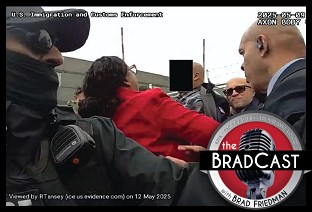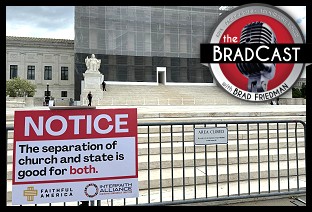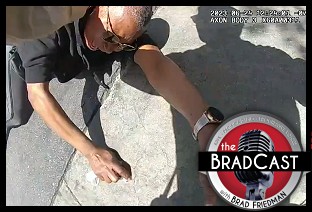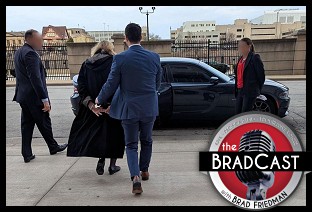As reported exclusively here last night, a stunning, thorough and well sourced letter was sent yesterday by the U.S. House Judiciary Committee Democrats demanding explanations from Ohio Sec. of State J. Kenneth Blackwell concerning numerous voting irregularities, mistabulation errors, voting-machine malfunctions, misallocations and reported voter suppression.
The detailed 15-page letter can be read here in PDF format.
We will be breaking more news momentarily about the Judiciary Committee's investigation and public hearings to be held next week as mentioned last night, along with additional news about that continuing investigation.
In the meantime, several new allegations were included in the 15-page letter to Blackwell, who also served as Co-Chair in Ohio for the Bush/Cheney 2004 Re-Elect Committee.
Many of the allegations to which the committee is seeking explanation from Blackwell have previously been discussed on the BRAD BLOG, though the letter adds some new details to several of them, all thoroughly sourced and footnoted in the original letter.
Here are some of the extended excerpts from the letter which shed additional and new light to some of the most troubling or noteworthy new pieces in the developing Ohio puzzle...
On election night, Warren County locked down its administration building and barred reporters from observing the counting. When that decision was questioned, County officials claimed they were responding to a terrorist threat that ranked a ô10" on a scale of 1 to 10, and that this information was received from an FBI agent. Despite repeated requests, County officials have declined to name that agent, however, and the FBI has stated that they had no information about a terror threat in Warren County. Your office has stated that it does not know of any other county that took these drastic measures.
...
This lockdown must be viewed in the context of the aberrational results in Warren County. In the 2000 Presidential election, the Democratic Presidential candidate, Al Gore, stopped running television commercials and pulled resources out of Ohio weeks before the election. He won 28% of the vote in Warren County. In 2004, the Democratic Presidential candidate, John Kerry, fiercely contested Ohio and independent groups put considerable resources into getting out the Democratic vote. Moreover, unlike in 2000, independent candidate
Ralph Nader was not on the Ohio ballot in 2004. Yet, the tallies reflect John Kerry receiving exactly the same percentage in Warren County as Gore received, 28%.
...
In another precinct, W Lexington G AB, 350 voters are registered according to the County's initial tallies. Yet, 434 voters cast ballots. As the tallies indicate, this would be an impossible 124% voter turnout. The breakdown on election night was initially reported to be 174 votes for Bush, and 246 votes for Kerry. We are advised that the Perry County Board of Elections has since issued a correction claiming that, due to a computer error, some votes were counted twice. We are advised that the new tallies state that only 224 people voted, and the tally is 90 votes for Bush and 127 votes for Kerry. This would make it appear that virtually every ballot was counted twice, which seems improbable.
(ed note: This next one certainly caught my attention!)...
In Perry County, there appears to be an extraordinarily high level voter registration, 91%; yet a substantial number of these voters have never voted and have no signature on file. Of the voters that are registered in Perry County an extraordinarily large number of voters are listed as having registered in 1977, a year in which there were no federal elections. Of these an exceptional number are listed as having registered on the exact same day: in total, 3,100 voters apparently registered in Perry County on November 8, 1977.
In Butler County, a Democratic Candidate for State Supreme Court, C. Ellen Connally received 59,532 votes. In contrast, the Kerry-Edwards ticket received only 54,185 votes, 5,000 less than the State Supreme Court candidate. Additionally, the victorious Republican candidate for State Supreme Court received approximately 40,000 less votes than the Bush-Cheney ticket. Further, Connally received 10,000 or more votes in excess of Kerry's total number of votes in five counties, and 5,000 more votes in excess of Kerry's total in ten others.
It must also be noted that Republican judicial candidates were reportedly ôawash in cash,ö with more than $1.4 million and were also supported by independent expenditures by the Ohio Chamber of Commerce.
While you may have found an explanation for these bizarre results, it appears to be wildly implausible that 5,000 voters waited in line to cast a vote for an underfunded Democratic Supreme Court candidate and then declined to cast a vote for the most well-funded Democratic Presidential campaign in history.
According to post election canvassing, many ballots were cast without any valid selection for president. For example, two precincts in Montgomery County had an undervote rate of over 25% each ľ accounting for nearly 6,000 voters who stood in line to vote, but purportedly declined to vote for president. This is in stark contrast to the 2% of undervoting county-wide. Disturbingly, predominantly Democratic precincts had 75% more undervotes than those that were predominantly Republican. It is inconceivable to us that such a large number of people supposedly did not have a preference for president in such a controversial and highly contested election.
On election day, a computerized voting machine in ward 1B in the Gahanna precinct of Franklin County recorded a total of 4,258 votes for President Bush and 260 votes for Democratic challenger, John Kerry. However, there are only 800 registered voters in that Gahanna precinct, and only 638 people cast votes at the New Life Church polling site. It was since discovered that a computer glitch resulted in the recording of 3,893 extra votes for President George W. Bush.
Fortunately, this glitch was caught and the numbers were adjusted to show President Bush's true vote count at 365 votes to Senator Kerry's 260 votes. However, many questions remain as to whether this kind of malfunction happened in other areas of Ohio.
In Miami County, with 100% of the precincts reporting on Wednesday, November 3, 2004, President Bush had received 20,807 votes, or 65.80% of the vote, and Senator Kerry had received 10,724 votes, or 33.92% of the vote. Miami reported 31,620 voters. Inexplicably, nearly 19,000 new ballots were added after all precincts reported, boosting President Bush's vote count to 33,039, or 65.77%, while Senator Kerry's vote percentage stayed exactly the same to three one-hundredths of a percentage point at 33.92%.
Roger Kearney of Rhombus Technologies, Ltd., the reporting company responsible for vote results of Miami County, has stated that the problem was not with his reporting and that the additional 19,000 votes came before 100% of the precincts were in. However, this does not explain how the vote count could change for President Bush, but not for Senator Kerry, after 19,000 new votes were added to the roster.
Throughout predominately Democratic areas in Ohio on election day, there were reports of long lines caused by inadequate numbers of voting machines. Evidence introduced in public hearings indicates that 68 machines in Franklin County were never deployed for voters, despite long lines for voters at that county, with some voters waiting from two to seven hours to cast their vote. The Franklin County Board of Elections reported that 68 voting machines were never placed on election day, and Franklin County BOE Director Matt Damschroder admitted on November 19, 2004 that 77 machines malfunctioned on Election Day. It has come to our attention that a county purchasing official who was on the line with Ward Moving and Storage Company, documented only 2,741 voting machines delivered through the November 2 election day. However, Franklin County's records reveal that they had 2,866 ômachines availableö on election day. This would mean that amid the two to seven hour waits in the inner city of Columbus, at least 125 machines remained unused on Election Day.
...
An analysis revealed a pattern of providing fewer machines to the Democratic city of Columbus, and more machines to the primarily Republican suburbs. At seven out of eight polling places, observers counted only three voting machines per location. According to the presiding judge at one polling site located at the Columbus Model Neighborhood facility at 1393 E. Broad St., there had been five machines during the 2004 primary. Moreover, at Douglas Elementary School, there had been four machines during the spring primary. In one Ohio voting precinct serving students from Kenyon College, some voters were required to wait more than eight hours to vote. There were reportedly only two voting machines at that precinct. The House Judiciary Committee staff has received first hand information confirming these reports.
...
A sampling [of Emails on file with House Judiciary Committee staff] include information about four hour waits at Precincts 35B and C in Columbus; seven hours waits for one voting machine per thousand voters, where the adjacent precinct had one station for 184 voters (this pattern was replicated in predominately African-American areas and areas with colleges); lines of four to five hours were ôthe order of the day in African American neighborhoods.ö
MORE BRAD BLOG COVERAGE ON ALL OF THESE MATTERS SOON...
Blue Lemur is currently offering additional analysis of the letter here.


 Sunday 'Cutting Corners' Toons
Sunday 'Cutting Corners' Toons 'A World of Tyrants,
'A World of Tyrants, 'Green News Report' 5/22/25
'Green News Report' 5/22/25
 'Dangerous Times': Climate Scientist Warns Trump 'Censorship' Endangering Nat'l Security: 'BradCast' 5/21/25
'Dangerous Times': Climate Scientist Warns Trump 'Censorship' Endangering Nat'l Security: 'BradCast' 5/21/25 And Then They Came for Members of Congress...: 'BradCast' 5/20/25
And Then They Came for Members of Congress...: 'BradCast' 5/20/25 'Green News Report' 5/20/25
'Green News Report' 5/20/25 Appeals Court Blocks Last Route for Voters to Challenge Violations of the VRA: 'BradCast' 5/19/25
Appeals Court Blocks Last Route for Voters to Challenge Violations of the VRA: 'BradCast' 5/19/25 Sunday 'Now Hoarding' Toons
Sunday 'Now Hoarding' Toons Mad World:
Mad World: 'Green News Report' 5/15/25
'Green News Report' 5/15/25 Plane Corruption and the Future of the DOJ: 'BradCast' 5/14/25
Plane Corruption and the Future of the DOJ: 'BradCast' 5/14/25 'Deeply Evil': GOP Proposes Largest Medicaid Cuts in History: 'BradCast' 5/13/25
'Deeply Evil': GOP Proposes Largest Medicaid Cuts in History: 'BradCast' 5/13/25 'Green News Report' 5/13/25
'Green News Report' 5/13/25 And Then They Came for the Mayors...: 'BradCast' 5/12/25
And Then They Came for the Mayors...: 'BradCast' 5/12/25 Sunday 'New Guy, Old Guy' Toons
Sunday 'New Guy, Old Guy' Toons Blowing Smoke. At the Vatican and White House: 'BradCast' 5/8/25
Blowing Smoke. At the Vatican and White House: 'BradCast' 5/8/25 'Green News Report' 5/8/25
'Green News Report' 5/8/25 SCOTUS Weighs Public Funding of Religious Schools: 'BradCast' 5/7/25
SCOTUS Weighs Public Funding of Religious Schools: 'BradCast' 5/7/25 Trump Judge Blocks NC GOP Theft of 2024 Supreme Court Seat: 'BradCast' 5/6/25
Trump Judge Blocks NC GOP Theft of 2024 Supreme Court Seat: 'BradCast' 5/6/25 Prosecutors Quit After U.S Attny Strikes Deal With Felon Cop: 'BradCast' 5/5/25
Prosecutors Quit After U.S Attny Strikes Deal With Felon Cop: 'BradCast' 5/5/25 Trump Losing Streak Continues into SECOND Hundred Days: 'BradCast' 5/1/25
Trump Losing Streak Continues into SECOND Hundred Days: 'BradCast' 5/1/25 100 Daze (w/ Digby and Driftglass): 'BradCast' 4/30/25
100 Daze (w/ Digby and Driftglass): 'BradCast' 4/30/25 Campaign to 'Impeach Trump Again' Gains Fresh Momentum: 'BradCast' 4/29/25
Campaign to 'Impeach Trump Again' Gains Fresh Momentum: 'BradCast' 4/29/25 And Then They Came for the Judges...: 'BradCast' 4/28/25
And Then They Came for the Judges...: 'BradCast' 4/28/25 Trump EPA Guts Enviro Justice Office: 'BradCast' 4/24/25
Trump EPA Guts Enviro Justice Office: 'BradCast' 4/24/25
 VA GOP VOTER REG FRAUDSTER OFF HOOK
VA GOP VOTER REG FRAUDSTER OFF HOOK Criminal GOP Voter Registration Fraud Probe Expanding in VA
Criminal GOP Voter Registration Fraud Probe Expanding in VA DOJ PROBE SOUGHT AFTER VA ARREST
DOJ PROBE SOUGHT AFTER VA ARREST Arrest in VA: GOP Voter Reg Scandal Widens
Arrest in VA: GOP Voter Reg Scandal Widens ALL TOGETHER: ROVE, SPROUL, KOCHS, RNC
ALL TOGETHER: ROVE, SPROUL, KOCHS, RNC LATimes: RNC's 'Fired' Sproul Working for Repubs in 'as Many as 30 States'
LATimes: RNC's 'Fired' Sproul Working for Repubs in 'as Many as 30 States' 'Fired' Sproul Group 'Cloned', Still Working for Republicans in At Least 10 States
'Fired' Sproul Group 'Cloned', Still Working for Republicans in At Least 10 States FINALLY: FOX ON GOP REG FRAUD SCANDAL
FINALLY: FOX ON GOP REG FRAUD SCANDAL COLORADO FOLLOWS FLORIDA WITH GOP CRIMINAL INVESTIGATION
COLORADO FOLLOWS FLORIDA WITH GOP CRIMINAL INVESTIGATION CRIMINAL PROBE LAUNCHED INTO GOP VOTER REGISTRATION FRAUD SCANDAL IN FL
CRIMINAL PROBE LAUNCHED INTO GOP VOTER REGISTRATION FRAUD SCANDAL IN FL Brad Breaks PA Photo ID & GOP Registration Fraud Scandal News on Hartmann TV
Brad Breaks PA Photo ID & GOP Registration Fraud Scandal News on Hartmann TV  CAUGHT ON TAPE: COORDINATED NATIONWIDE GOP VOTER REG SCAM
CAUGHT ON TAPE: COORDINATED NATIONWIDE GOP VOTER REG SCAM CRIMINAL ELECTION FRAUD COMPLAINT FILED AGAINST GOP 'FRAUD' FIRM
CRIMINAL ELECTION FRAUD COMPLAINT FILED AGAINST GOP 'FRAUD' FIRM RICK SCOTT GETS ROLLED IN GOP REGISTRATION FRAUD SCANDAL
RICK SCOTT GETS ROLLED IN GOP REGISTRATION FRAUD SCANDAL VIDEO: Brad Breaks GOP Reg Fraud Scandal on Hartmann TV
VIDEO: Brad Breaks GOP Reg Fraud Scandal on Hartmann TV RNC FIRES NATIONAL VOTER REGISTRATION FIRM FOR FRAUD
RNC FIRES NATIONAL VOTER REGISTRATION FIRM FOR FRAUD EXCLUSIVE: Intvw w/ FL Official Who First Discovered GOP Reg Fraud
EXCLUSIVE: Intvw w/ FL Official Who First Discovered GOP Reg Fraud GOP REGISTRATION FRAUD FOUND IN FL
GOP REGISTRATION FRAUD FOUND IN FL

































